NSG3PHN Essay: Palliative Healthcare Nursing Roles and Strategies
VerifiedAdded on 2023/01/03
|8
|2434
|94
Essay
AI Summary
This essay delves into the critical aspects of primary healthcare nursing, with a specific focus on palliative care. It begins by defining primary healthcare and the crucial role of nurses within this system, particularly highlighting the specialized responsibilities of palliative care nurses. The essay provides a comprehensive overview of palliative care nursing roles, including patient care, pain management, symptom alleviation, medication administration, patient and family education, and emotional support. It then identifies depression as a significant health issue affecting palliative care patients and explores the application of health promotion strategies based on the Ottawa Charter to address this issue. The essay also distinguishes the relationship between primary care and primary healthcare, explaining why palliative care nursing is considered a primary healthcare nursing role. The essay concludes by emphasizing the importance of health promotion and disease prevention within the healthcare system and highlights the need for further research in this sector.
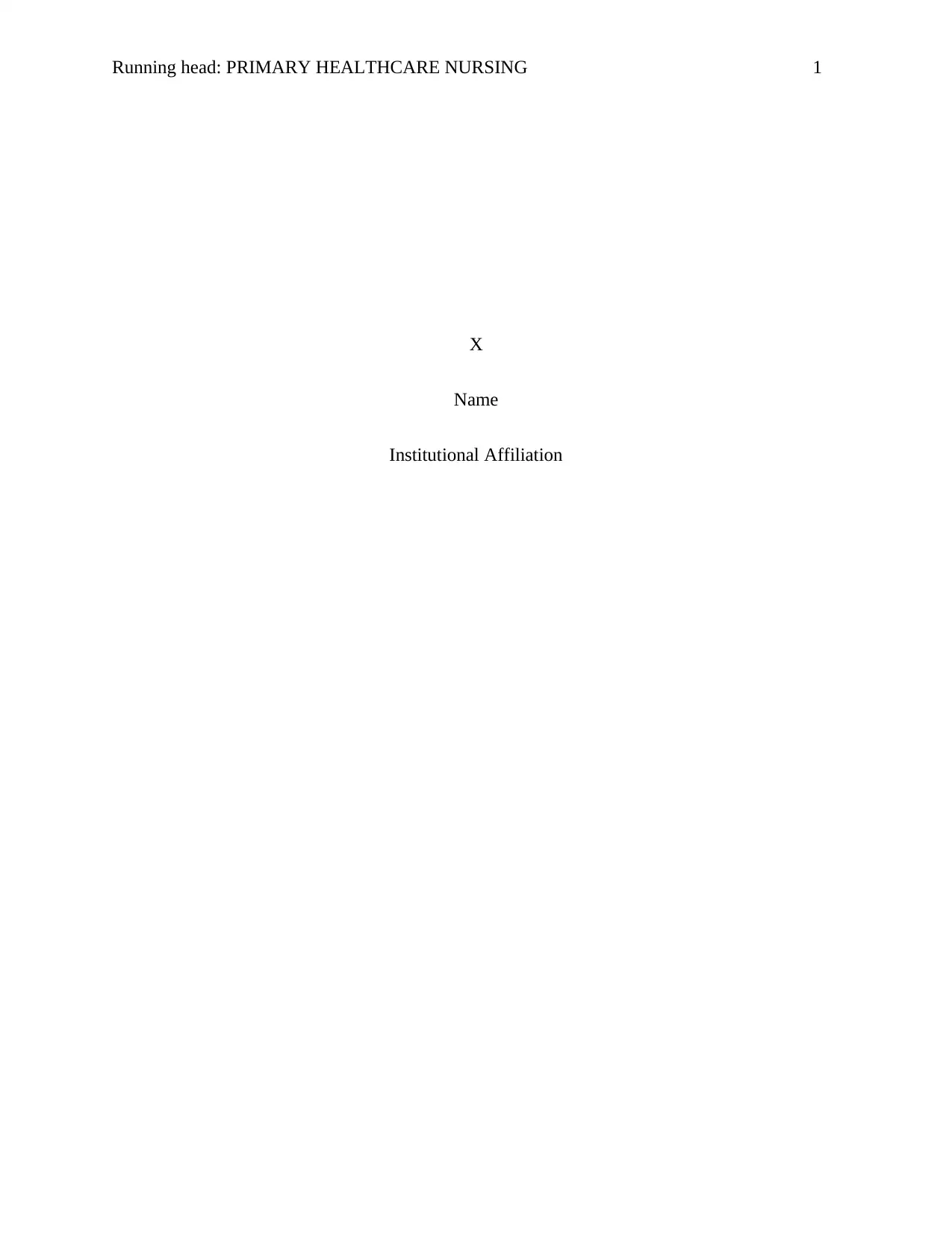
Running head: PRIMARY HEALTHCARE NURSING 1
X
Name
Institutional Affiliation
X
Name
Institutional Affiliation
Paraphrase This Document
Need a fresh take? Get an instant paraphrase of this document with our AI Paraphraser
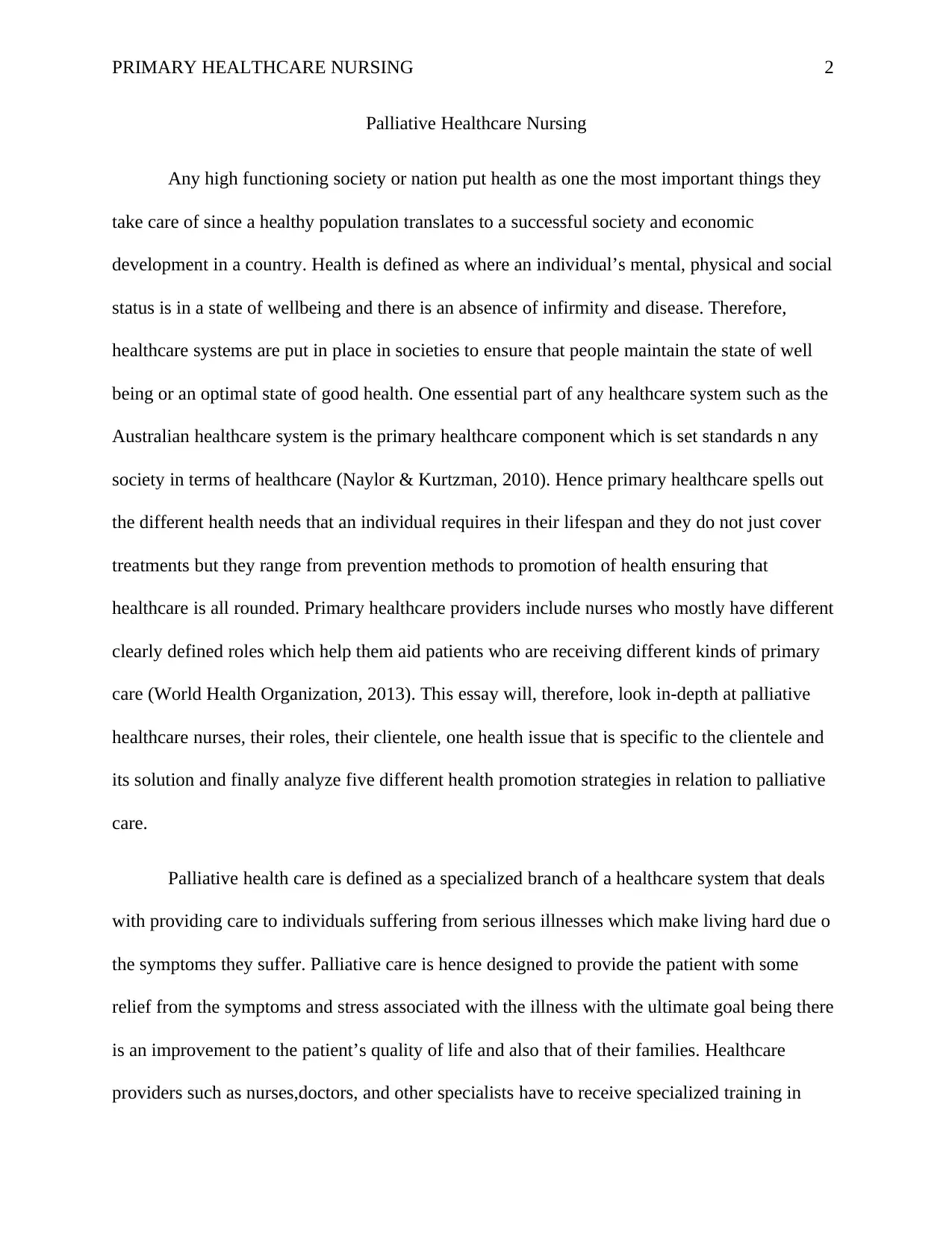
PRIMARY HEALTHCARE NURSING 2
Palliative Healthcare Nursing
Any high functioning society or nation put health as one the most important things they
take care of since a healthy population translates to a successful society and economic
development in a country. Health is defined as where an individual’s mental, physical and social
status is in a state of wellbeing and there is an absence of infirmity and disease. Therefore,
healthcare systems are put in place in societies to ensure that people maintain the state of well
being or an optimal state of good health. One essential part of any healthcare system such as the
Australian healthcare system is the primary healthcare component which is set standards n any
society in terms of healthcare (Naylor & Kurtzman, 2010). Hence primary healthcare spells out
the different health needs that an individual requires in their lifespan and they do not just cover
treatments but they range from prevention methods to promotion of health ensuring that
healthcare is all rounded. Primary healthcare providers include nurses who mostly have different
clearly defined roles which help them aid patients who are receiving different kinds of primary
care (World Health Organization, 2013). This essay will, therefore, look in-depth at palliative
healthcare nurses, their roles, their clientele, one health issue that is specific to the clientele and
its solution and finally analyze five different health promotion strategies in relation to palliative
care.
Palliative health care is defined as a specialized branch of a healthcare system that deals
with providing care to individuals suffering from serious illnesses which make living hard due o
the symptoms they suffer. Palliative care is hence designed to provide the patient with some
relief from the symptoms and stress associated with the illness with the ultimate goal being there
is an improvement to the patient’s quality of life and also that of their families. Healthcare
providers such as nurses,doctors, and other specialists have to receive specialized training in
Palliative Healthcare Nursing
Any high functioning society or nation put health as one the most important things they
take care of since a healthy population translates to a successful society and economic
development in a country. Health is defined as where an individual’s mental, physical and social
status is in a state of wellbeing and there is an absence of infirmity and disease. Therefore,
healthcare systems are put in place in societies to ensure that people maintain the state of well
being or an optimal state of good health. One essential part of any healthcare system such as the
Australian healthcare system is the primary healthcare component which is set standards n any
society in terms of healthcare (Naylor & Kurtzman, 2010). Hence primary healthcare spells out
the different health needs that an individual requires in their lifespan and they do not just cover
treatments but they range from prevention methods to promotion of health ensuring that
healthcare is all rounded. Primary healthcare providers include nurses who mostly have different
clearly defined roles which help them aid patients who are receiving different kinds of primary
care (World Health Organization, 2013). This essay will, therefore, look in-depth at palliative
healthcare nurses, their roles, their clientele, one health issue that is specific to the clientele and
its solution and finally analyze five different health promotion strategies in relation to palliative
care.
Palliative health care is defined as a specialized branch of a healthcare system that deals
with providing care to individuals suffering from serious illnesses which make living hard due o
the symptoms they suffer. Palliative care is hence designed to provide the patient with some
relief from the symptoms and stress associated with the illness with the ultimate goal being there
is an improvement to the patient’s quality of life and also that of their families. Healthcare
providers such as nurses,doctors, and other specialists have to receive specialized training in
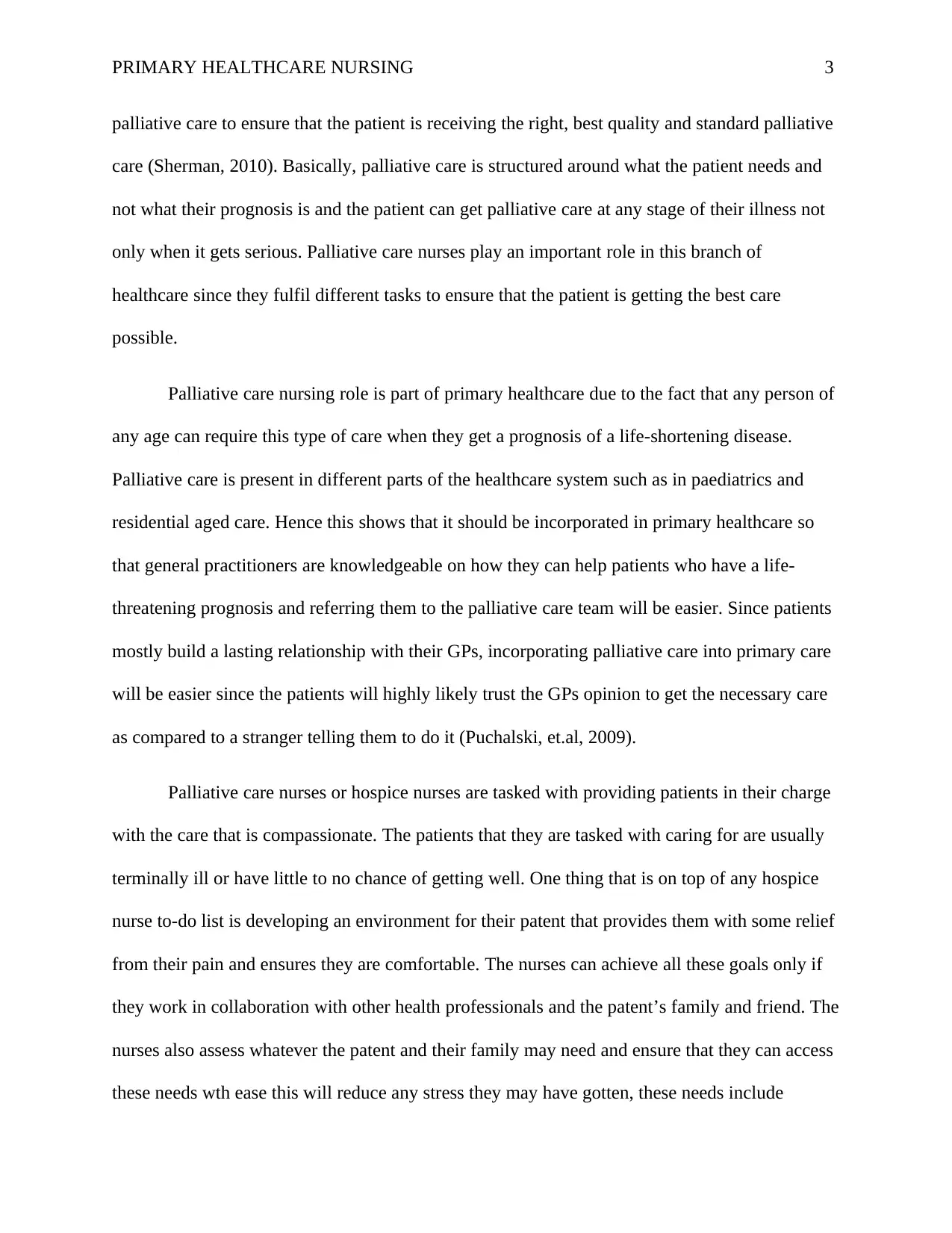
PRIMARY HEALTHCARE NURSING 3
palliative care to ensure that the patient is receiving the right, best quality and standard palliative
care (Sherman, 2010). Basically, palliative care is structured around what the patient needs and
not what their prognosis is and the patient can get palliative care at any stage of their illness not
only when it gets serious. Palliative care nurses play an important role in this branch of
healthcare since they fulfil different tasks to ensure that the patient is getting the best care
possible.
Palliative care nursing role is part of primary healthcare due to the fact that any person of
any age can require this type of care when they get a prognosis of a life-shortening disease.
Palliative care is present in different parts of the healthcare system such as in paediatrics and
residential aged care. Hence this shows that it should be incorporated in primary healthcare so
that general practitioners are knowledgeable on how they can help patients who have a life-
threatening prognosis and referring them to the palliative care team will be easier. Since patients
mostly build a lasting relationship with their GPs, incorporating palliative care into primary care
will be easier since the patients will highly likely trust the GPs opinion to get the necessary care
as compared to a stranger telling them to do it (Puchalski, et.al, 2009).
Palliative care nurses or hospice nurses are tasked with providing patients in their charge
with the care that is compassionate. The patients that they are tasked with caring for are usually
terminally ill or have little to no chance of getting well. One thing that is on top of any hospice
nurse to-do list is developing an environment for their patent that provides them with some relief
from their pain and ensures they are comfortable. The nurses can achieve all these goals only if
they work in collaboration with other health professionals and the patent’s family and friend. The
nurses also assess whatever the patent and their family may need and ensure that they can access
these needs wth ease this will reduce any stress they may have gotten, these needs include
palliative care to ensure that the patient is receiving the right, best quality and standard palliative
care (Sherman, 2010). Basically, palliative care is structured around what the patient needs and
not what their prognosis is and the patient can get palliative care at any stage of their illness not
only when it gets serious. Palliative care nurses play an important role in this branch of
healthcare since they fulfil different tasks to ensure that the patient is getting the best care
possible.
Palliative care nursing role is part of primary healthcare due to the fact that any person of
any age can require this type of care when they get a prognosis of a life-shortening disease.
Palliative care is present in different parts of the healthcare system such as in paediatrics and
residential aged care. Hence this shows that it should be incorporated in primary healthcare so
that general practitioners are knowledgeable on how they can help patients who have a life-
threatening prognosis and referring them to the palliative care team will be easier. Since patients
mostly build a lasting relationship with their GPs, incorporating palliative care into primary care
will be easier since the patients will highly likely trust the GPs opinion to get the necessary care
as compared to a stranger telling them to do it (Puchalski, et.al, 2009).
Palliative care nurses or hospice nurses are tasked with providing patients in their charge
with the care that is compassionate. The patients that they are tasked with caring for are usually
terminally ill or have little to no chance of getting well. One thing that is on top of any hospice
nurse to-do list is developing an environment for their patent that provides them with some relief
from their pain and ensures they are comfortable. The nurses can achieve all these goals only if
they work in collaboration with other health professionals and the patent’s family and friend. The
nurses also assess whatever the patent and their family may need and ensure that they can access
these needs wth ease this will reduce any stress they may have gotten, these needs include
⊘ This is a preview!⊘
Do you want full access?
Subscribe today to unlock all pages.

Trusted by 1+ million students worldwide
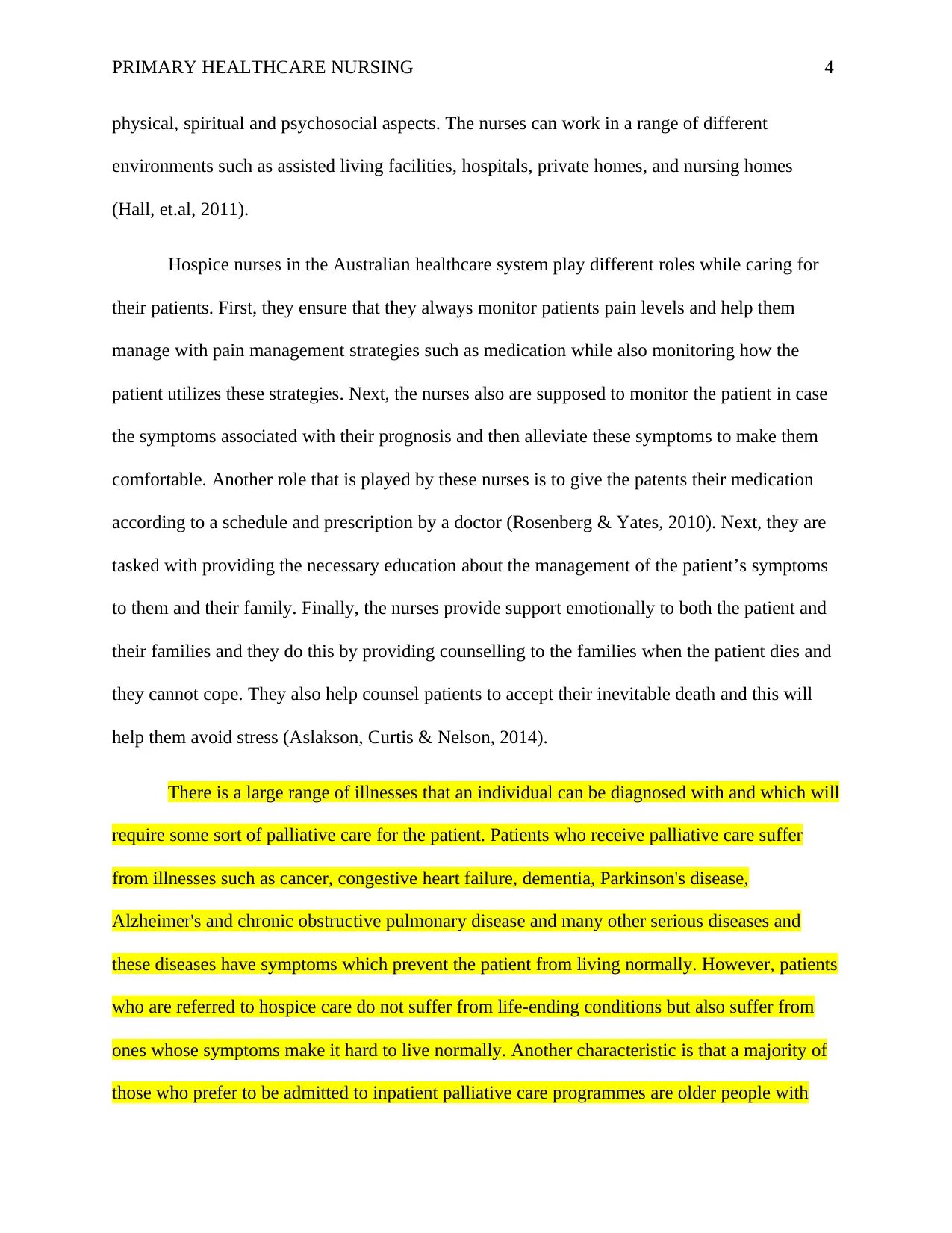
PRIMARY HEALTHCARE NURSING 4
physical, spiritual and psychosocial aspects. The nurses can work in a range of different
environments such as assisted living facilities, hospitals, private homes, and nursing homes
(Hall, et.al, 2011).
Hospice nurses in the Australian healthcare system play different roles while caring for
their patients. First, they ensure that they always monitor patients pain levels and help them
manage with pain management strategies such as medication while also monitoring how the
patient utilizes these strategies. Next, the nurses also are supposed to monitor the patient in case
the symptoms associated with their prognosis and then alleviate these symptoms to make them
comfortable. Another role that is played by these nurses is to give the patents their medication
according to a schedule and prescription by a doctor (Rosenberg & Yates, 2010). Next, they are
tasked with providing the necessary education about the management of the patient’s symptoms
to them and their family. Finally, the nurses provide support emotionally to both the patient and
their families and they do this by providing counselling to the families when the patient dies and
they cannot cope. They also help counsel patients to accept their inevitable death and this will
help them avoid stress (Aslakson, Curtis & Nelson, 2014).
There is a large range of illnesses that an individual can be diagnosed with and which will
require some sort of palliative care for the patient. Patients who receive palliative care suffer
from illnesses such as cancer, congestive heart failure, dementia, Parkinson's disease,
Alzheimer's and chronic obstructive pulmonary disease and many other serious diseases and
these diseases have symptoms which prevent the patient from living normally. However, patients
who are referred to hospice care do not suffer from life-ending conditions but also suffer from
ones whose symptoms make it hard to live normally. Another characteristic is that a majority of
those who prefer to be admitted to inpatient palliative care programmes are older people with
physical, spiritual and psychosocial aspects. The nurses can work in a range of different
environments such as assisted living facilities, hospitals, private homes, and nursing homes
(Hall, et.al, 2011).
Hospice nurses in the Australian healthcare system play different roles while caring for
their patients. First, they ensure that they always monitor patients pain levels and help them
manage with pain management strategies such as medication while also monitoring how the
patient utilizes these strategies. Next, the nurses also are supposed to monitor the patient in case
the symptoms associated with their prognosis and then alleviate these symptoms to make them
comfortable. Another role that is played by these nurses is to give the patents their medication
according to a schedule and prescription by a doctor (Rosenberg & Yates, 2010). Next, they are
tasked with providing the necessary education about the management of the patient’s symptoms
to them and their family. Finally, the nurses provide support emotionally to both the patient and
their families and they do this by providing counselling to the families when the patient dies and
they cannot cope. They also help counsel patients to accept their inevitable death and this will
help them avoid stress (Aslakson, Curtis & Nelson, 2014).
There is a large range of illnesses that an individual can be diagnosed with and which will
require some sort of palliative care for the patient. Patients who receive palliative care suffer
from illnesses such as cancer, congestive heart failure, dementia, Parkinson's disease,
Alzheimer's and chronic obstructive pulmonary disease and many other serious diseases and
these diseases have symptoms which prevent the patient from living normally. However, patients
who are referred to hospice care do not suffer from life-ending conditions but also suffer from
ones whose symptoms make it hard to live normally. Another characteristic is that a majority of
those who prefer to be admitted to inpatient palliative care programmes are older people with
Paraphrase This Document
Need a fresh take? Get an instant paraphrase of this document with our AI Paraphraser
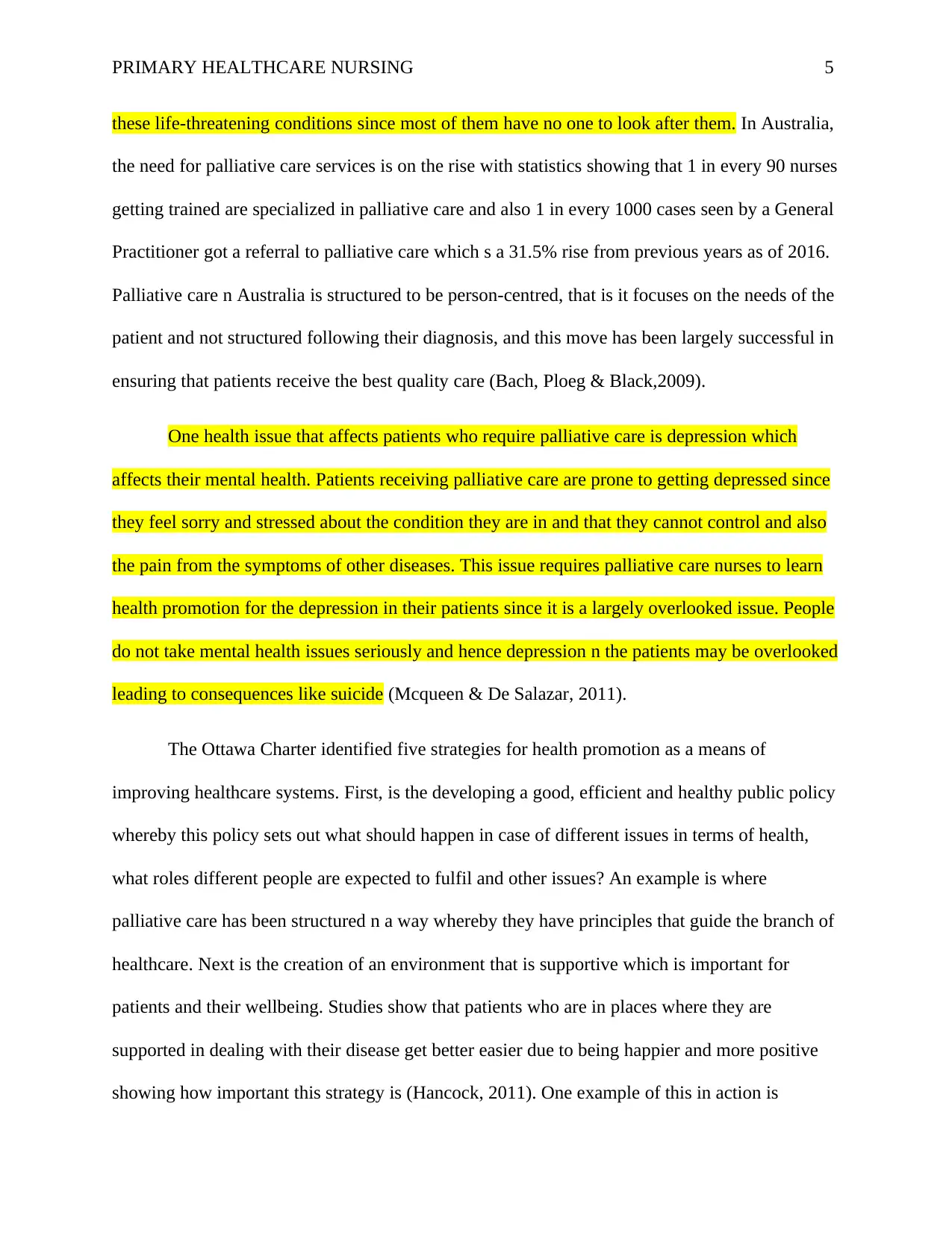
PRIMARY HEALTHCARE NURSING 5
these life-threatening conditions since most of them have no one to look after them. In Australia,
the need for palliative care services is on the rise with statistics showing that 1 in every 90 nurses
getting trained are specialized in palliative care and also 1 in every 1000 cases seen by a General
Practitioner got a referral to palliative care which s a 31.5% rise from previous years as of 2016.
Palliative care n Australia is structured to be person-centred, that is it focuses on the needs of the
patient and not structured following their diagnosis, and this move has been largely successful in
ensuring that patients receive the best quality care (Bach, Ploeg & Black,2009).
One health issue that affects patients who require palliative care is depression which
affects their mental health. Patients receiving palliative care are prone to getting depressed since
they feel sorry and stressed about the condition they are in and that they cannot control and also
the pain from the symptoms of other diseases. This issue requires palliative care nurses to learn
health promotion for the depression in their patients since it is a largely overlooked issue. People
do not take mental health issues seriously and hence depression n the patients may be overlooked
leading to consequences like suicide (Mcqueen & De Salazar, 2011).
The Ottawa Charter identified five strategies for health promotion as a means of
improving healthcare systems. First, is the developing a good, efficient and healthy public policy
whereby this policy sets out what should happen in case of different issues in terms of health,
what roles different people are expected to fulfil and other issues? An example is where
palliative care has been structured n a way whereby they have principles that guide the branch of
healthcare. Next is the creation of an environment that is supportive which is important for
patients and their wellbeing. Studies show that patients who are in places where they are
supported in dealing with their disease get better easier due to being happier and more positive
showing how important this strategy is (Hancock, 2011). One example of this in action is
these life-threatening conditions since most of them have no one to look after them. In Australia,
the need for palliative care services is on the rise with statistics showing that 1 in every 90 nurses
getting trained are specialized in palliative care and also 1 in every 1000 cases seen by a General
Practitioner got a referral to palliative care which s a 31.5% rise from previous years as of 2016.
Palliative care n Australia is structured to be person-centred, that is it focuses on the needs of the
patient and not structured following their diagnosis, and this move has been largely successful in
ensuring that patients receive the best quality care (Bach, Ploeg & Black,2009).
One health issue that affects patients who require palliative care is depression which
affects their mental health. Patients receiving palliative care are prone to getting depressed since
they feel sorry and stressed about the condition they are in and that they cannot control and also
the pain from the symptoms of other diseases. This issue requires palliative care nurses to learn
health promotion for the depression in their patients since it is a largely overlooked issue. People
do not take mental health issues seriously and hence depression n the patients may be overlooked
leading to consequences like suicide (Mcqueen & De Salazar, 2011).
The Ottawa Charter identified five strategies for health promotion as a means of
improving healthcare systems. First, is the developing a good, efficient and healthy public policy
whereby this policy sets out what should happen in case of different issues in terms of health,
what roles different people are expected to fulfil and other issues? An example is where
palliative care has been structured n a way whereby they have principles that guide the branch of
healthcare. Next is the creation of an environment that is supportive which is important for
patients and their wellbeing. Studies show that patients who are in places where they are
supported in dealing with their disease get better easier due to being happier and more positive
showing how important this strategy is (Hancock, 2011). One example of this in action is
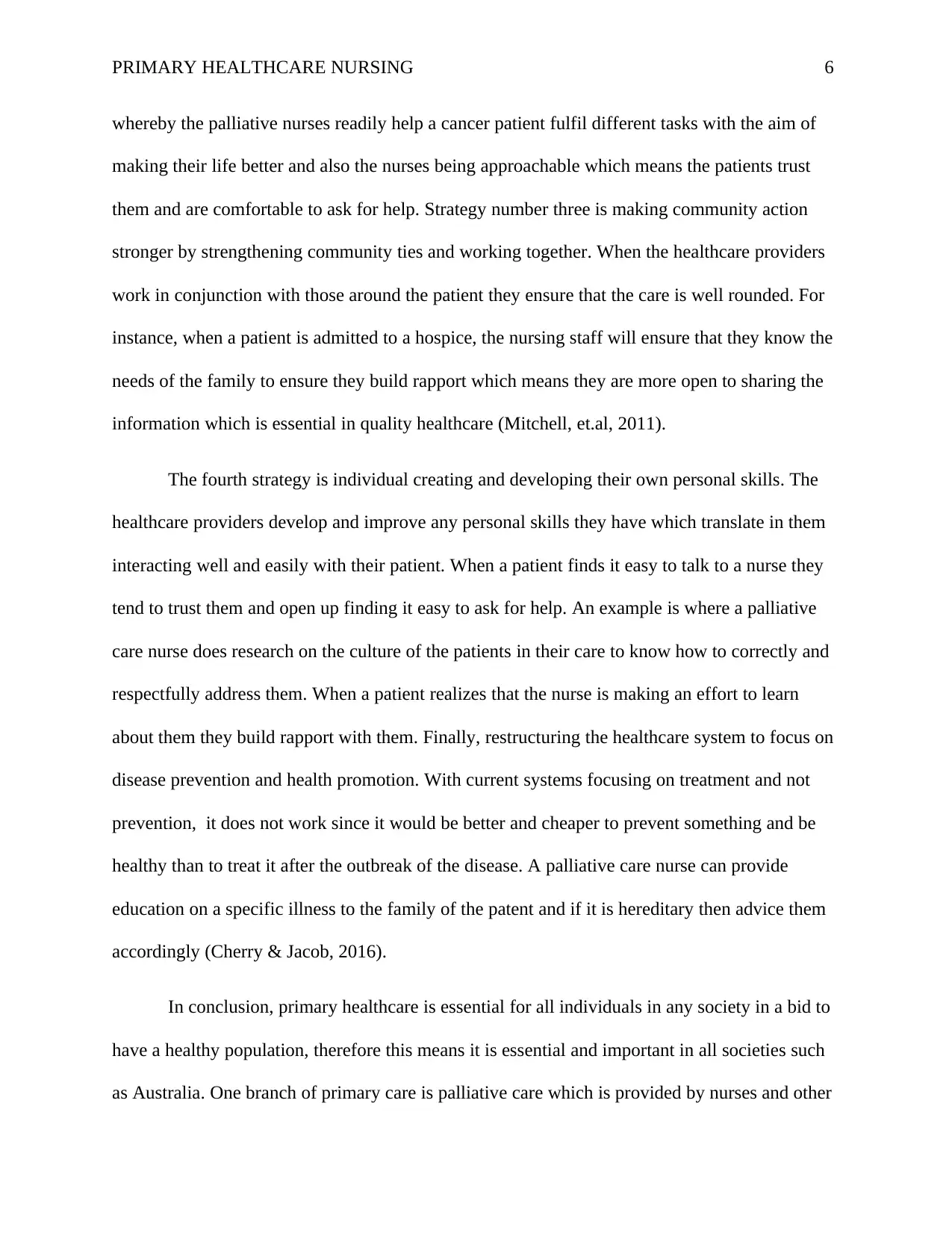
PRIMARY HEALTHCARE NURSING 6
whereby the palliative nurses readily help a cancer patient fulfil different tasks with the aim of
making their life better and also the nurses being approachable which means the patients trust
them and are comfortable to ask for help. Strategy number three is making community action
stronger by strengthening community ties and working together. When the healthcare providers
work in conjunction with those around the patient they ensure that the care is well rounded. For
instance, when a patient is admitted to a hospice, the nursing staff will ensure that they know the
needs of the family to ensure they build rapport which means they are more open to sharing the
information which is essential in quality healthcare (Mitchell, et.al, 2011).
The fourth strategy is individual creating and developing their own personal skills. The
healthcare providers develop and improve any personal skills they have which translate in them
interacting well and easily with their patient. When a patient finds it easy to talk to a nurse they
tend to trust them and open up finding it easy to ask for help. An example is where a palliative
care nurse does research on the culture of the patients in their care to know how to correctly and
respectfully address them. When a patient realizes that the nurse is making an effort to learn
about them they build rapport with them. Finally, restructuring the healthcare system to focus on
disease prevention and health promotion. With current systems focusing on treatment and not
prevention, it does not work since it would be better and cheaper to prevent something and be
healthy than to treat it after the outbreak of the disease. A palliative care nurse can provide
education on a specific illness to the family of the patent and if it is hereditary then advice them
accordingly (Cherry & Jacob, 2016).
In conclusion, primary healthcare is essential for all individuals in any society in a bid to
have a healthy population, therefore this means it is essential and important in all societies such
as Australia. One branch of primary care is palliative care which is provided by nurses and other
whereby the palliative nurses readily help a cancer patient fulfil different tasks with the aim of
making their life better and also the nurses being approachable which means the patients trust
them and are comfortable to ask for help. Strategy number three is making community action
stronger by strengthening community ties and working together. When the healthcare providers
work in conjunction with those around the patient they ensure that the care is well rounded. For
instance, when a patient is admitted to a hospice, the nursing staff will ensure that they know the
needs of the family to ensure they build rapport which means they are more open to sharing the
information which is essential in quality healthcare (Mitchell, et.al, 2011).
The fourth strategy is individual creating and developing their own personal skills. The
healthcare providers develop and improve any personal skills they have which translate in them
interacting well and easily with their patient. When a patient finds it easy to talk to a nurse they
tend to trust them and open up finding it easy to ask for help. An example is where a palliative
care nurse does research on the culture of the patients in their care to know how to correctly and
respectfully address them. When a patient realizes that the nurse is making an effort to learn
about them they build rapport with them. Finally, restructuring the healthcare system to focus on
disease prevention and health promotion. With current systems focusing on treatment and not
prevention, it does not work since it would be better and cheaper to prevent something and be
healthy than to treat it after the outbreak of the disease. A palliative care nurse can provide
education on a specific illness to the family of the patent and if it is hereditary then advice them
accordingly (Cherry & Jacob, 2016).
In conclusion, primary healthcare is essential for all individuals in any society in a bid to
have a healthy population, therefore this means it is essential and important in all societies such
as Australia. One branch of primary care is palliative care which is provided by nurses and other
⊘ This is a preview!⊘
Do you want full access?
Subscribe today to unlock all pages.

Trusted by 1+ million students worldwide
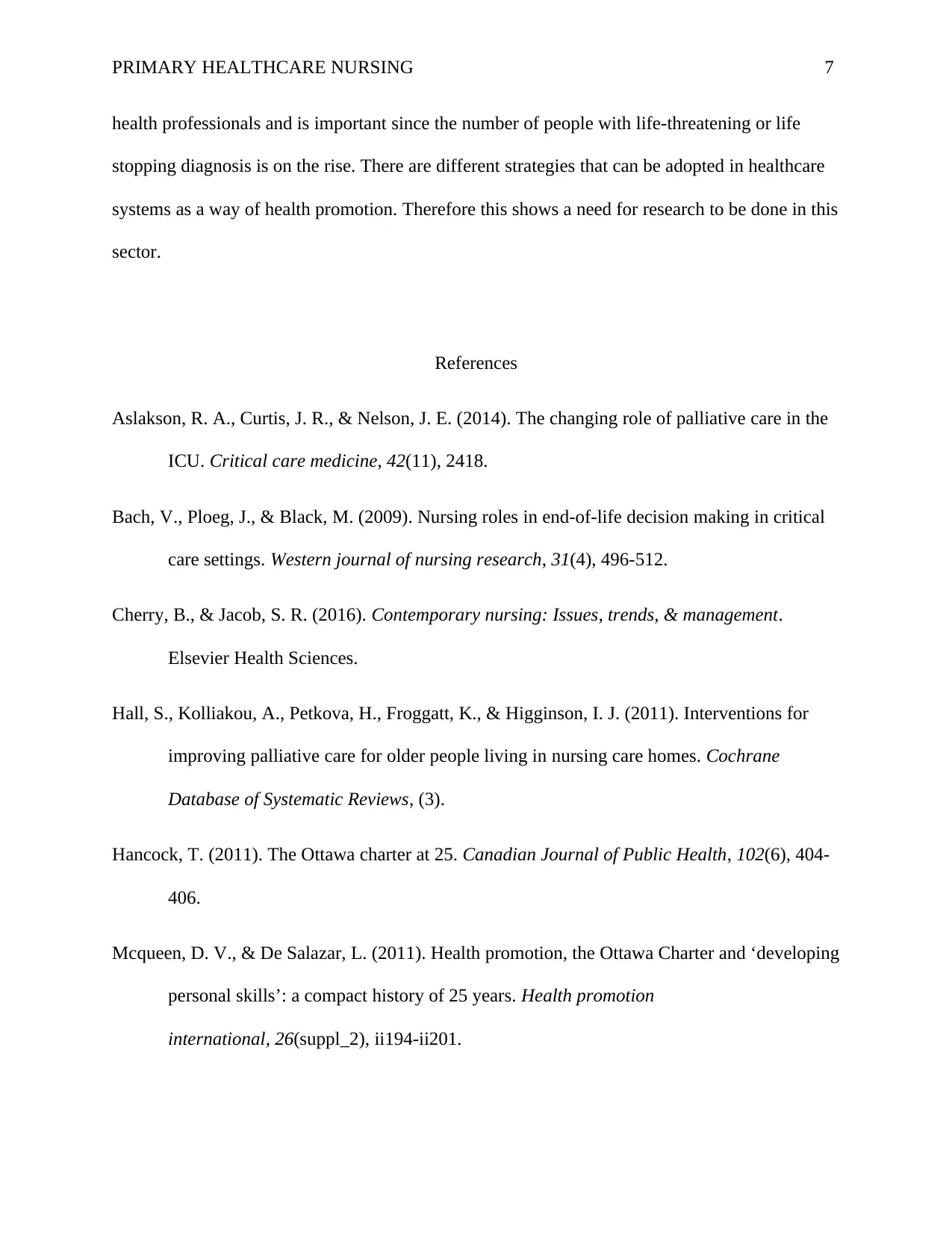
PRIMARY HEALTHCARE NURSING 7
health professionals and is important since the number of people with life-threatening or life
stopping diagnosis is on the rise. There are different strategies that can be adopted in healthcare
systems as a way of health promotion. Therefore this shows a need for research to be done in this
sector.
References
Aslakson, R. A., Curtis, J. R., & Nelson, J. E. (2014). The changing role of palliative care in the
ICU. Critical care medicine, 42(11), 2418.
Bach, V., Ploeg, J., & Black, M. (2009). Nursing roles in end-of-life decision making in critical
care settings. Western journal of nursing research, 31(4), 496-512.
Cherry, B., & Jacob, S. R. (2016). Contemporary nursing: Issues, trends, & management.
Elsevier Health Sciences.
Hall, S., Kolliakou, A., Petkova, H., Froggatt, K., & Higginson, I. J. (2011). Interventions for
improving palliative care for older people living in nursing care homes. Cochrane
Database of Systematic Reviews, (3).
Hancock, T. (2011). The Ottawa charter at 25. Canadian Journal of Public Health, 102(6), 404-
406.
Mcqueen, D. V., & De Salazar, L. (2011). Health promotion, the Ottawa Charter and ‘developing
personal skills’: a compact history of 25 years. Health promotion
international, 26(suppl_2), ii194-ii201.
health professionals and is important since the number of people with life-threatening or life
stopping diagnosis is on the rise. There are different strategies that can be adopted in healthcare
systems as a way of health promotion. Therefore this shows a need for research to be done in this
sector.
References
Aslakson, R. A., Curtis, J. R., & Nelson, J. E. (2014). The changing role of palliative care in the
ICU. Critical care medicine, 42(11), 2418.
Bach, V., Ploeg, J., & Black, M. (2009). Nursing roles in end-of-life decision making in critical
care settings. Western journal of nursing research, 31(4), 496-512.
Cherry, B., & Jacob, S. R. (2016). Contemporary nursing: Issues, trends, & management.
Elsevier Health Sciences.
Hall, S., Kolliakou, A., Petkova, H., Froggatt, K., & Higginson, I. J. (2011). Interventions for
improving palliative care for older people living in nursing care homes. Cochrane
Database of Systematic Reviews, (3).
Hancock, T. (2011). The Ottawa charter at 25. Canadian Journal of Public Health, 102(6), 404-
406.
Mcqueen, D. V., & De Salazar, L. (2011). Health promotion, the Ottawa Charter and ‘developing
personal skills’: a compact history of 25 years. Health promotion
international, 26(suppl_2), ii194-ii201.
Paraphrase This Document
Need a fresh take? Get an instant paraphrase of this document with our AI Paraphraser
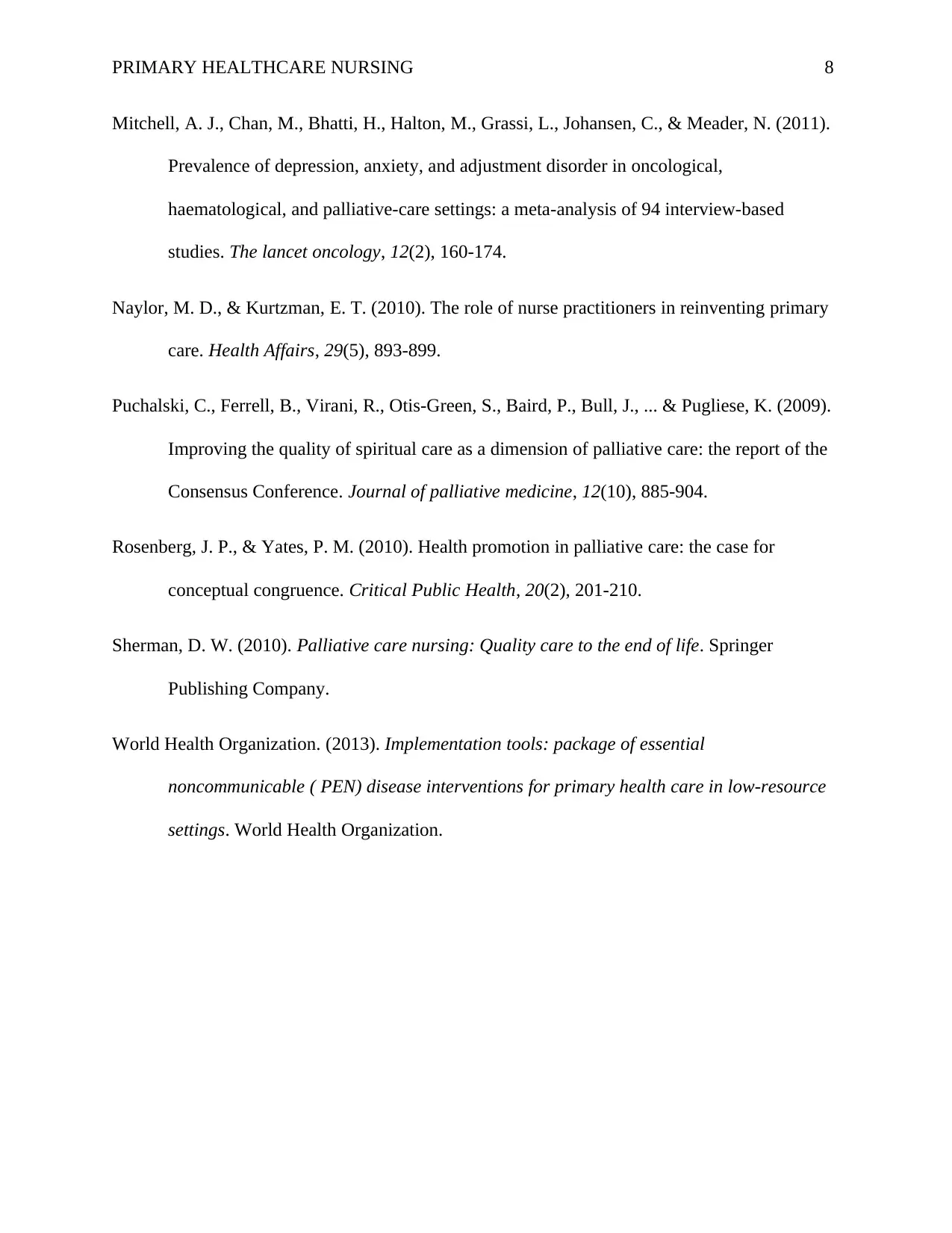
PRIMARY HEALTHCARE NURSING 8
Mitchell, A. J., Chan, M., Bhatti, H., Halton, M., Grassi, L., Johansen, C., & Meader, N. (2011).
Prevalence of depression, anxiety, and adjustment disorder in oncological,
haematological, and palliative-care settings: a meta-analysis of 94 interview-based
studies. The lancet oncology, 12(2), 160-174.
Naylor, M. D., & Kurtzman, E. T. (2010). The role of nurse practitioners in reinventing primary
care. Health Affairs, 29(5), 893-899.
Puchalski, C., Ferrell, B., Virani, R., Otis-Green, S., Baird, P., Bull, J., ... & Pugliese, K. (2009).
Improving the quality of spiritual care as a dimension of palliative care: the report of the
Consensus Conference. Journal of palliative medicine, 12(10), 885-904.
Rosenberg, J. P., & Yates, P. M. (2010). Health promotion in palliative care: the case for
conceptual congruence. Critical Public Health, 20(2), 201-210.
Sherman, D. W. (2010). Palliative care nursing: Quality care to the end of life. Springer
Publishing Company.
World Health Organization. (2013). Implementation tools: package of essential
noncommunicable ( PEN) disease interventions for primary health care in low-resource
settings. World Health Organization.
Mitchell, A. J., Chan, M., Bhatti, H., Halton, M., Grassi, L., Johansen, C., & Meader, N. (2011).
Prevalence of depression, anxiety, and adjustment disorder in oncological,
haematological, and palliative-care settings: a meta-analysis of 94 interview-based
studies. The lancet oncology, 12(2), 160-174.
Naylor, M. D., & Kurtzman, E. T. (2010). The role of nurse practitioners in reinventing primary
care. Health Affairs, 29(5), 893-899.
Puchalski, C., Ferrell, B., Virani, R., Otis-Green, S., Baird, P., Bull, J., ... & Pugliese, K. (2009).
Improving the quality of spiritual care as a dimension of palliative care: the report of the
Consensus Conference. Journal of palliative medicine, 12(10), 885-904.
Rosenberg, J. P., & Yates, P. M. (2010). Health promotion in palliative care: the case for
conceptual congruence. Critical Public Health, 20(2), 201-210.
Sherman, D. W. (2010). Palliative care nursing: Quality care to the end of life. Springer
Publishing Company.
World Health Organization. (2013). Implementation tools: package of essential
noncommunicable ( PEN) disease interventions for primary health care in low-resource
settings. World Health Organization.
1 out of 8
Related Documents
Your All-in-One AI-Powered Toolkit for Academic Success.
+13062052269
info@desklib.com
Available 24*7 on WhatsApp / Email
![[object Object]](/_next/static/media/star-bottom.7253800d.svg)
Unlock your academic potential
Copyright © 2020–2025 A2Z Services. All Rights Reserved. Developed and managed by ZUCOL.





